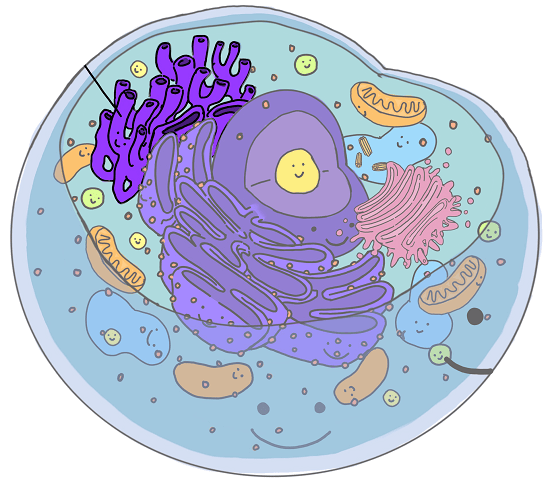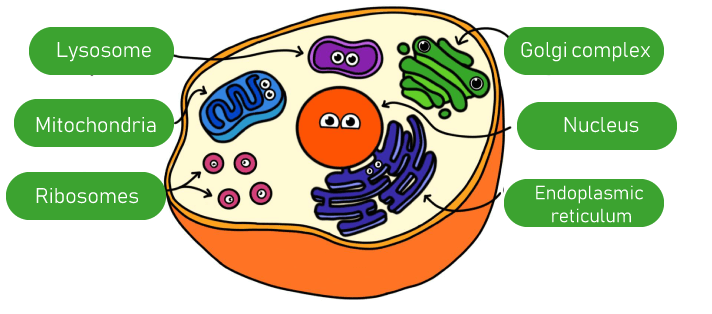Cell Organelles DefinitionCell organelles are specialized parts of cells that carry out certain tasks and support the general health of the cell. These structures carry out the cell's metabolic and biochemical activities, such as energy production, protein synthesis, and waste elimination. 
Our knowledge of how cells work and interact with their environment depends on how cell organelles are defined. There are several organelles, each with a special structure and purpose. The nucleus, mitochondria, endoplasmic reticulum, Golgi apparatus, lysosomes, and cytoskeleton are a few of the most significant organelles. Most cells' nuclei, the most noticeable organelles, are where DNA, or genetic material, is kept. It has a nucleolus, which is in charge of producing ribosomal RNA, is encircled by a double membrane, and is located within this structure. The process of cellular respiration, carried out by the mitochondria, produces ATP, the energy carrier. They feature a special two-membrane structure, with the inner membrane housing the enzymes needed for energy generation. Protein synthesis and transport are carried out by a network of membrane-bound tubes and sacs called the endoplasmic reticulum. It is split into two types: Smooth Endoplasmic Reticulum (SER), which is in charge of lipid synthesis and detoxification, and Rough Endoplasmic Reticulum (RER), which contains ribosomes attached to its surface and is in charge of protein synthesis. The Golgi apparatus must package and sort proteins and lipids produced in the cell. Cisternae, or flattened membrane-bound sacs, make up its structure. Cellular trash and debris are broken down and recycled by tiny organelles called lysosomes. They can digest proteins, carbs, and lipids because they include digestive enzymes. Last but not least, the cytoskeleton is a web of protein fibers that gives the cell stability and structure. It controls the movement of organelles inside the cell and the shape and movement of the cell itself. History of Study of Cell OrganellesSince the beginning of the 19th century, there has been a rich history of research on cell organelles. Robert Hooke, one of the first scientists to study cells and their organelles, used a microscope to study a thin slice of cork in 1665 and discovered tiny, box-like structures that he dubbed "cells." However, further in-depth research on cell organelles did not start until the late 19th century. Camillo Golgi, one of the pioneers in this area, created a staining method that allowed him to see the brain's nerve cells' internal organization. He was able to locate a structure now known as the Golgi apparatus using this method. Early in the 20th century, other scientists started observing the structure of cells and their organelles using sophisticated microscope techniques. Albert Claude, one of the most significant of these researchers, utilized electron microscopy to see into cells in the 1940s. His research resulted in the identification of several novel organelles, including the lysosome and endoplasmic reticulum. In the 1950s, George Palade significantly advanced our understanding of cell organelles by using a method known as cell fractionation to separate and examine specific organelles. He used this to learn about the ribosome, which is important for protein synthesis. Since then, new methods and tools have been developed that enable more accurate and thorough observations of cellular processes and structures, furthering our understanding of cell organelles. Today, studying cell organelles is a crucial area of research in cell biology, genetics, and medicine. It has implications for everything from treating diseases to understanding the beginnings of life on Earth. Composition of Cell OrganelleCell organelles are composed of various components that cooperate to carry out their roles. Proteins, lipids, carbohydrates, and nucleic acids can all be found in organelles. One of the most crucial components of cell organelles is protein, which performs many unique tasks for each Organelle. For instance, structural proteins support organelles' stability and shape maintenance, while enzymes catalyze certain chemical reactions inside the cell. Lipids, including phospholipids, are crucial parts of the organelles inside cells. They make up the membranes of organelles, which are crucial for separating the various cellular activities and safeguarding the environment inside the cell. Although less prevalent than proteins and lipids, carbohydrates can also be present in cell organelles. In addition to being an energy source, they may participate in cellular communication and recognition. Organelles like the nucleus and mitochondria comprise mostly nucleic acids, DNA, and RNA. While RNA participates in creating proteins and other biological functions, DNA is responsible for transmitting genetic information from parent cells to offspring cells. Organelles also contain a variety of other molecules and structures that support their general function in addition to these components. For instance, the Golgi apparatus comprises a complex network of membranes and vesicles in charge of packaging and transporting proteins and lipids. In contrast, the mitochondria include several enzymes and proteins in energy production. 
Functions of Cell OrganelleCell organelles are specialized parts of cells that carry out certain tasks to guarantee the health of the cell and, eventually, the organism. The following are a few of the main duties of cell organelles:
Overall, the vast range of tasks performed by cell organelles makes them crucial for preserving the healthy operation of cells and organisms. Together, they ensure that cells can do the intricate tasks required for life, such as waste clearance, protein synthesis, and energy production. Importance of Cell Organelle
Medical Issues Related to Cell-OrganelleGenetic abnormalities and acquired diseases are two health issues connected to cell organelles. Here are a few instances:
To create novel medicines and treatments for various illnesses, it is crucial to comprehend the function of cell organelles in disease. Differences Between Plant and Animal Cell OrganellesThere are some distinctions between the types of organelles found in plant and animal cells. Animal cells do not contain cell walls, chloroplasts, or bigger central vacuoles like in plants. Contrarily, plant cells lack centrosomes and lysosomes, which are present in animal cells. In plant cells, the cell wall is a strong structure outside the plasma membrane and serves as support and defense for the cell. Only plant cells include chloroplasts, an organelle that produces photosynthesis by harnessing sunlight's energy to create glucose. Large organelles called central vacuoles are present in plant cells and are used to store materials like water and ions. Animal cells only include centrosomes, an essential organelle for cell division. They are made up of two centrioles, which are spherical microtubule structures. Organelles called lysosomes contain digestive enzymes that help break down numerous chemicals in cells. Therapies and Treatments for Cell Organelle-Related DiseasesA few instances of cell organelle-related disorders that are currently being researched and treated include:
The development of therapies and treatments for disorders involving cell organelles is still in its early phases. Gene therapy, enzyme replacement therapy, and stem cell transplantation are a few treatments that are currently being investigated. Gene therapy replaces or fixes faulty genes to get cells back to working normally. Enzyme replacement treatment includes giving patients missing or damaged enzymes to help them operate normally. Healthy stem cells are transplanted during a stem cell procedure to replace cells that have been destroyed or are sick. To create efficient medicines and treatments for illnesses connected to cell organelles, further study is required to completely understand the physical structure of cell organelles and their roles.
Next TopicComputer Graphics Definition
|
 For Videos Join Our Youtube Channel: Join Now
For Videos Join Our Youtube Channel: Join Now
Feedback
- Send your Feedback to [email protected]
Help Others, Please Share









